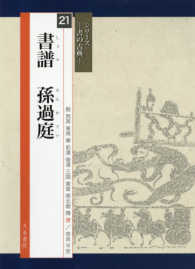- ホーム
- > 洋書
- > 英文書
- > History / World
Full Description
Classifications are central to archaeology. Yet the theoretical literature on the subject, both in archaeology and the philosophy of science, bears very little relationship to what actually occurs in practice. This problem has long interested William Adams, a field archaeologist, and Ernest Adams, a philosopher of science, who describe their book as an ethnography of archaeological classification. It is a study of the various ways in which field archaeologists set about making and using classifications to meet a variety of practical needs. The authors first discuss how humans form concepts. They then describe and analyse in detail a specific example of an archaeological classification, and go on to consider what theoretical generalizations can be derived from the study of actual in-use classifications. Throughout the book, they stress the importance of having a clearly defined purpose and practical procedures when developing and applying classifications.
Contents
List of figures; List of tables; The archaeologist's preface; The philosopher's preface; Part I. Introductory: 1. Beginning points; 2. Introductory theses; Part II. The Nature of Types and Typologies: 3. Dimensions and elements of 'typehood'; 4. Perceptual and conceptual foundations; 5. The dialectics of type formulation; 6. The nature of types; 7. The structure of typologies; 8. A synthetic definition of typology and type; Part III. Typology in Action: The Medieval Nubian Pottery Typology: 9. Origin and development of the Nubian typology; 10. Basic features of the Nubian typology; 11. The uses of the Nubian Typology; 12. Philosophical implications; Part IV. Pragmatics of Archaeological Typology: 13. The starting point: purpose; 14. The determinants of types: variables and attributes; 15. The making of types: formulation, designation and description; 16. The uses of type: typing and sorting; 17. The ordering of types: taxonomy and seriation; 18. Variation and variability in archaeological classifications; 19. The bottom line: practicality; 20. Principles of practical typology; 21. Information-theoretic formulations; Part V. Classification, Explanation and Theory: 22. The Typological Debate; 23. Issues and non-issues in the Typological Debate; 24. Conceptual problems; 25. The use and abuse of theory; 26. Paradigms and progress; Appendices; References; Index.








